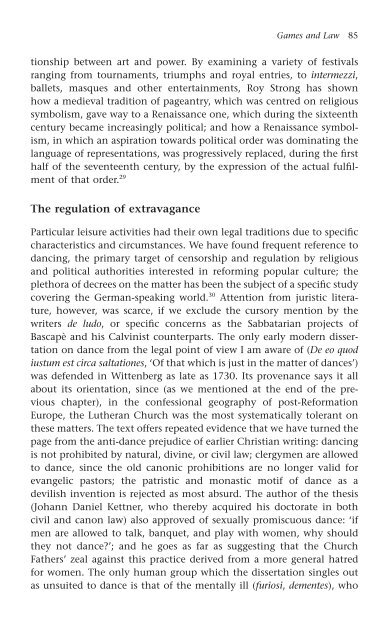Recreation in the Renaissance
Recreation in the Renaissance
Recreation in the Renaissance
- No tags were found...
Create successful ePaper yourself
Turn your PDF publications into a flip-book with our unique Google optimized e-Paper software.
Games and Law 85<br />
tionship between art and power. By exam<strong>in</strong><strong>in</strong>g a variety of festivals<br />
rang<strong>in</strong>g from tournaments, triumphs and royal entries, to <strong>in</strong>termezzi,<br />
ballets, masques and o<strong>the</strong>r enterta<strong>in</strong>ments, Roy Strong has shown<br />
how a medieval tradition of pageantry, which was centred on religious<br />
symbolism, gave way to a <strong>Renaissance</strong> one, which dur<strong>in</strong>g <strong>the</strong> sixteenth<br />
century became <strong>in</strong>creas<strong>in</strong>gly political; and how a <strong>Renaissance</strong> symbolism,<br />
<strong>in</strong> which an aspiration towards political order was dom<strong>in</strong>at<strong>in</strong>g <strong>the</strong><br />
language of representations, was progressively replaced, dur<strong>in</strong>g <strong>the</strong> first<br />
half of <strong>the</strong> seventeenth century, by <strong>the</strong> expression of <strong>the</strong> actual fulfilment<br />
of that order. 29<br />
The regulation of extravagance<br />
Particular leisure activities had <strong>the</strong>ir own legal traditions due to specific<br />
characteristics and circumstances. We have found frequent reference to<br />
danc<strong>in</strong>g, <strong>the</strong> primary target of censorship and regulation by religious<br />
and political authorities <strong>in</strong>terested <strong>in</strong> reform<strong>in</strong>g popular culture; <strong>the</strong><br />
plethora of decrees on <strong>the</strong> matter has been <strong>the</strong> subject of a specific study<br />
cover<strong>in</strong>g <strong>the</strong> German-speak<strong>in</strong>g world. 30 Attention from juristic literature,<br />
however, was scarce, if we exclude <strong>the</strong> cursory mention by <strong>the</strong><br />
writers de ludo, or specific concerns as <strong>the</strong> Sabbatarian projects of<br />
Bascapè and his Calv<strong>in</strong>ist counterparts. The only early modern dissertation<br />
on dance from <strong>the</strong> legal po<strong>in</strong>t of view I am aware of (De eo quod<br />
iustum est circa saltationes, ‘Of that which is just <strong>in</strong> <strong>the</strong> matter of dances’)<br />
was defended <strong>in</strong> Wittenberg as late as 1730. Its provenance says it all<br />
about its orientation, s<strong>in</strong>ce (as we mentioned at <strong>the</strong> end of <strong>the</strong> previous<br />
chapter), <strong>in</strong> <strong>the</strong> confessional geography of post-Reformation<br />
Europe, <strong>the</strong> Lu<strong>the</strong>ran Church was <strong>the</strong> most systematically tolerant on<br />
<strong>the</strong>se matters. The text offers repeated evidence that we have turned <strong>the</strong><br />
page from <strong>the</strong> anti-dance prejudice of earlier Christian writ<strong>in</strong>g: danc<strong>in</strong>g<br />
is not prohibited by natural, div<strong>in</strong>e, or civil law; clergymen are allowed<br />
to dance, s<strong>in</strong>ce <strong>the</strong> old canonic prohibitions are no longer valid for<br />
evangelic pastors; <strong>the</strong> patristic and monastic motif of dance as a<br />
devilish <strong>in</strong>vention is rejected as most absurd. The author of <strong>the</strong> <strong>the</strong>sis<br />
(Johann Daniel Kettner, who <strong>the</strong>reby acquired his doctorate <strong>in</strong> both<br />
civil and canon law) also approved of sexually promiscuous dance: ‘if<br />
men are allowed to talk, banquet, and play with women, why should<br />
<strong>the</strong>y not dance’; and he goes as far as suggest<strong>in</strong>g that <strong>the</strong> Church<br />
Fa<strong>the</strong>rs’ zeal aga<strong>in</strong>st this practice derived from a more general hatred<br />
for women. The only human group which <strong>the</strong> dissertation s<strong>in</strong>gles out<br />
as unsuited to dance is that of <strong>the</strong> mentally ill (furiosi, dementes), who










